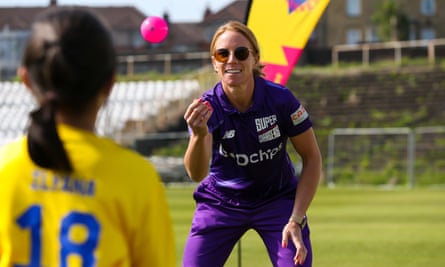It’s more than three years now since the England and Wales Cricket Board announced its plan to create a completely new format for the franchise tournament they were intending to launch in 2020. On Wednesday, delayed by a year because of Covid, the Hundred finally gets under way when the Oval Invincibles play Manchester Originals in a women’s match at the Oval, with the first men’s game between the same teams a day later. Now the pressure really hits – and it isn’t just the players who will be feeling it.
When I first heard about the idea I was completely against it. I did not come into the game from a traditional family environment, and I never found it that complicated to grasp. I didn’t see the need for a new format, and all the questions that arise from it – would it be revolutionary or nearly the same? In what way would it be easier for people new to the game to pick up?
Being a county person through and through, the more I heard of the impact it is likely to have on the counties, the more opposed I became. Squeezing four formats into a summer is a tough challenge, and a new high-profile tournament would affect the reputation and the relevance of more established competitions such as the Royal London One-Day Cup. Some counties would lose a lot of players to the Hundred, and suddenly their squad depth, which is being tested by Covid anyway, would be pretty much gone.
What has shifted me from then to now is understanding the need. I want to see gender parity, younger and more diverse crowds, and lots of families enjoying the game now and in the future. There is a need to shift the image of cricket, and what has really struck me about the Hundred is that it’s not just a fresh lick of paint on the same old game. When they began to market it, I liked what I saw. Many people in the game think it looks quite gimmicky, but with respect they aren’t the target audience.
I think the brands and the colours look exciting, and I also get excited when I see some of the bands that have been booked, people like Lady Leshurr and Becky Hill who traditional cricket fans wouldn’t know. The marketing has been completely designed for a younger, more diverse audience, which is exactly as it should be. A lot of the traditional cricket crowd have been hostile to the Hundred since it was announced, and find the marketing does not appeal to them, but I think that if Jofra Archer were charging in, or Jos Buttler had his bat in his hand, they would still be interested. These weren’t the people who needed to have cricket marketed to them.

Something else that has stood out in all the imagery I’ve seen promoting the tournament is that men and women are at the forefront in equal measure. The narrative of gender parity in the Hundred is unique at the elite level of the sport in this country and is pretty powerful in this modern era.
There is equal prize money, and massive new exposure for women cricketers: the fact they are launching the tournament with a women’s game in a standalone fixture is exciting and powerful. Most of the games are double-headers, with a women’s match being played before the men’s, which is not an ideal long-term scenario, but particularly given the pandemic it reduces practical challenges. Long-term I’d like to see more standalone women’s games, but there’s time for that.
The shame is that the competition that we see on Wednesday will not be the one the ECB had envisaged. We have lost an entire year and because of the pandemic many of the big-name players who had committed to it – the likes of Alyssa Healy, Meg Lanning and Beth Mooney from the women’s teams, or Glenn Maxwell, David Warner and Kieron Pollard from the men’s – have pulled out.
The tournament was going to attract genuinely world-class talent, which would have given it the star factor it might need. I think the quality of the cricket should be good – in their ODI series against Pakistan, England showed how much depth there is in the domestic game – but without the big-name international players will it be enough to get people to buy tickets or to turn on their screens?
So how, given everything, should we measure the success of this year’s tournament? Most importantly, the format needs to work. Games have to be short, sharp and exciting, attracting families and broadcasters from start to finish. If they end up being the length of Twenty20s it would be confusing for fans and it would be hard for the ECB to justify their innovation. Then we need to see good crowds – with Covid restrictions lifted just in time I’ll be looking for attendances that average around 50% across the tournament. But I will also want to see data that demonstrates that it’s a new audience, a game open and welcoming to women, people with disabilities and different socioeconomic groups. If the stands are full of existing cricket fans, I’m not sure it would constitute a success.
Finally, it has to show it can help secure the future of the ECB, which needs to be able to generate revenue outside the international game. Good viewing figures and ticket sales will help it with that, particularly with a hopefully realistic chance of attracting more big-name players next year.
Over time I have come to see the potential of this new competition. Maybe a completely new format wasn’t necessary, but I like the marketing, the imagery, the kind of music that’s been booked. I love the commitment to gender equality and the direction of travel in terms of engaging new people. But the existing game will pay a price for all of this, and when we look back that cost has to have been worth it. There’s no doubt that the Hundred is a gamble. Now it’s time to see if it’s going to pay off.

